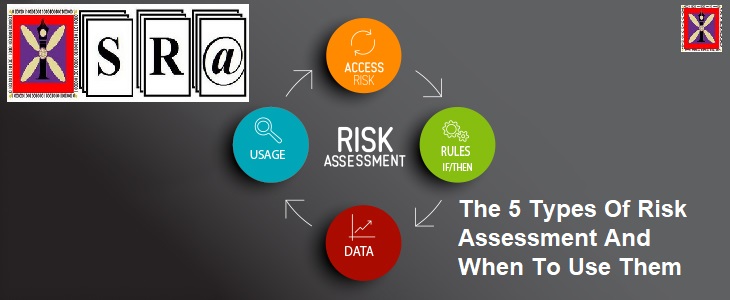Preface: Mange your risk
Risk is an unforeseeable factor. You never know, when something will go wrong, and you have to do crisis management for that unavoidable situation. Whenever you take up any project, it is advisable to do the risk management beforehand. If you are ready to handle the risk, you can easily solve any problem. Be prepared with the strategy to manage risk with the risk management template.
5 Effective Steps for Project Risk Management
Step 1: Identification of the Risk
You along with your team needs to identify, understand and reveal the risk that can have an impact on your project and its outcome.
Step 2: Analyzation of the Risk
You and your team together need to analyze the risk factor. You need to develop an understanding of the risk and its outcomes.
Step 3: Evaluation of the Risk
The evaluation of the risk will help you to understand the magnitude of the risk. After this evaluation only you will be able to understand whether you are ready to take the risk or you should think of a way to tackle it.
Step 4: Treatment
If you see you can handle the risk you can move forward but if you see that the risk will bring upon a great problem, you can either move forward to save the risk and do crisis management after the damage has occurred, or change to another plan.
Step 5: Move Forward
“Accept the inevitable and turn it to your advantage”. This is the best way for you and your team to move forward with the project.
The 5 Types Of Risk Assessment And When To Use Them
In this post, we are going to look at the 5 types of risk assessment in health and safety, and when to use them. Before we start, it’s important to keep in mind that different types of risk assessment can be used together. Some parts of each type might be present in a single risk assessment.

In this post, we are going to look at the 5 types of risk assessment in health and safety, and when to use them. Before we start, it’s important to keep in mind that different types of risk assessment can be used together. Some parts of each type might be present in a single risk assessment.
A health and safety risk assessment considers the hazards present in a task or activity. It looks at the likelihood of harm that might occur. And the severity of that harm. A risk assessment should take 5 steps:
- Identify the hazards
- Decide who might be harmed and how
- Evaluate the risks and decide on precautions
- Record your significant findings
- Review your assessment and update if necessary
With any type of risk assessment, the assessor should have experience in the type of work they are assessing, to know what hazards need to be managed. They should also be competent in the risk assessment process, to be able to identify high risks and what action might be needed to reduce risk.
1. Qualitative Risk Assessment
The qualitative risk assessment is the most common form of risk assessment. You will often see this type of risk assessment in workplaces. It is based on the personal judgement and expertise of the assessor. They will often use their own experience, but will also consult with others carrying out the activity and best practice guidance to reach their decisions.
Any health and safety risk assessment will start with a simple qualitative assessment. In a qualitative risk assessment, the assessor will categorise risk into levels, usually high, medium or low.
A qualitative risk assessment should be a systematic examination of what in the workplace could cause harm to people, so that decisions can be made as to whether existing precautions or control measures are adequate or whether more needs to be done to prevent harm.
A qualitative risk assessment will look at the risk of somebody being injured, and if that is high, medium or low. Just like any other type of risk assessment, any high risks will need to be addressed as a priority. Low-level risks can be looked at later, or might not need further action to be taken.
Risk = Severity x Likelihood
Just because a qualitative risk assessment doesn’t need to involve numbers, the risk is still calculated by the severity of harm x likelihood of harm. Qualitative risk assessment involves making a formal judgement on the consequence (severity) and probability (likelihood).
2. Quantitative Risk Assessment
The quantitative risk assessment is used to measure risk by assigning a numerical value. This type of risk assessment will more likely be used with major hazards, like aircraft design, complex chemical or nuclear plants.
Quantities measured could be the presence of hazards from chemicals or machinery for example, or modelling techniques and estimates.
In carrying out quantitative risk assessments, special quantitative tools and techniques will be used for hazard identification, and to estimate the severity of the consequences and the likelihood of realisation of the hazards.
Often qualitative risk assessments might assign numbers to different levels of risk. Like the 3 x 3 or 5 x 5 risk matrix. This doesn’t turn a qualitative risk assessment into a quantitative one. If the risk assessment is still based on the judgement of the assessor assigning risk values, it is still primarily a qualitative assessment.
Sometimes, a qualitative risk assessment might become semi-quantitative, for example when some hazards or aspects can be measured, and others are based on judgement.
3. Generic Risk Assessment
The Management of Health and Safety at Work Regulations (1999) require employers to carry out an assessment of the risks arising from their work activities.
3.—(1) Every employer shall make a suitable and sufficient assessment of
- the risks to the health and safety of his employees to which they are exposed whilst they are at work; and
- the risks to the health and safety of persons not in his employment arising out of or in connection with the conduct by him of his undertaking,
Generic risk assessments cover common hazards for a task or activity. The idea behind generic risk assessment is to cut down on duplication of effort and paperwork. This type of risk assessment will consider the hazards for an activity in a single assessment, where that activity may be carried out across different areas of the workplace or different sites.
A generic risk assessment will often be used for similar activities or equipment across different sites, departments or companies. It can act as a risk assessment template, covering the types of hazards and risks that are usually present for the activity.
It’s important to remember that while the risks from an activity may be common across different sites, changes in the environment can affect risk levels, and even introduce new hazards. It’s probably best to use generic risk assessments as a starting point for a site-specific risk assessment.
4. Site-Specific Risk Assessment
A site-specific risk assessment is a risk assessment that has been completed for a specific item of work, that takes account of the site-location, environment, and people doing the work.
Your site-specific risk assessment might be qualitative, or quantitative. You might start off with a generic risk assessment template. But you should finish with a site-specific risk assessment that is suitable and sufficient for the hazards present.
For example, image a generic risk assessment for drilling. It would cover risks like entanglement with rotating parts, projectiles, contact with hot parts of the tool during use, vibration and noise. But could there be unusual hazards on your site that might change the risk level? You could be drilling within a confined space. A vessel or a tank. Access may be limited. Flammable gases could be present. You could need additional controls like atmosphere testing, a permit to work, a rescue plan.
A site-specific risk assessment will do more than look at common hazards. It will also address the unusual. Hazards that might only apply to that specific situation, on that particular day.
5. Dynamic Risk Assessment
A dynamic risk assessment is a process of assessing risk in an on the spot situation. This type of risk assessment is often used to cope with unknown risks and handling uncertainty. It might be used by the emergency services, or care workers for example, who need to deal with developing and changing situations. These types of environments need to be continually assessed. If there are significant changes, is the original risk assessment still valid? Should you try to deal with the situation? Is it safe to continue?
It is not always possible to prepare for every risk or hazard. A written risk assessment should assess the level of ‘unknown’ risks. Where a certain element of dynamic risk analysis is required, workers need to have the skills and awareness to recognise and deal with danger.

For example, if a lone worker feels uneasy about a situation, there should be a process in place to get help. Or action that can be taken, like emergency procedures, if things go wrong. Rather than relying on the assessor’s judgement, a dynamic risk assessment relies on the worker’s judgement. They take on the role of the risk assessor at that moment.
Where there are dynamic elements to a risk assessment, workers need to have the confidence and judgement to know when it is not safe to proceed. Extra training will help to develop these skills, particularly with lone workers who might not have anyone close by to ask advice from.
Risk Analysis Techniques
There are two types of risk analysis and assessments conducted in organizations. They are qualitative risk analysis methods and quantitative methods of risk analysis. The qualitative methods are widely used means for companies to assess and monitor day-to-day risks faced by them. This makes them widely used approaches. The different risk analysis methods are used based on the type of organization, type of project, and more.
Risk analysis and management experts are usually the ones who know what risk analysis methods are best suited for specific projects. Using the right method is also important because it can determine the project’s success rate. Some of the most commonly used and popular risk analysis techniques are listed below:
- Delphi Technique of Risk Analysis
- Decision Tree Analysis
- Probability and Consequence Matrix
- SWIFT Analysis
- Bow-Tie Analysiss
Delphi Technique for Risk Analysis
The Delphi technique for risk analysis is quite similar to a brainstorming session. The concerned teams must work with risk analysts and other security specialists to come up with different potential threats and vulnerabilities to their organization or project. The crucial point of what makes the Delphi technique works is that it uses risk professionals and experts. Without utilizing the expert skills, it becomes no different from a regular brainstorming session and will not yield very successful results.
After the brainstorming session is complete, risk analysts and team members work together to evaluate their identified risks and analyze them. All the experts make their lists of potential threats and their evaluations individually and then compare them to create a complete risk register to document all the risks before creating a risk management strategy.
Decision Tree Analysis
The decision tree analysis is used to create various outcomes or consequences of an action. This risk analysis method is widely used because project teams can be prepared for any and all possible outcomes and create strategies to ensure that they can achieve the best one out of them. The decision tree analysis is used to chart or create a pathway for teams to follow to avoid risks and follow the best course of action for their project.
A decision tree analysis is mainly used when project teams do not know or are uncertain of the final outcome. This way, they can gauge the different possibilities and prepare for the worst of them, and expect the best. The process involves creating different outcomes, analyzing the probabilities of them occurring, and then creating a pathway or a course of action to achieve the best results.
Probability and Consequence Matrix
This is the most widely used method of understanding the impact and severity of any risk. The probability and consequence matrix is created to help teams rank the identified threats, vulnerabilities, and risks. This is done to identify how severe a risk could be if materialized. The severity of risks is calculated by multiplying the level of impact of the risk against the likelihood or probability of the risk-taking place.
By identifying and calculating the different factors of risk in the probability and consequence matrix, it also becomes easier for risk analysts and professionals to work with teams and come up with various risk avoidance and mitigation strategies for risk management.
SWIFT Analysis
The SWIFT Analysis stands for Structured What If Technique. This analysis method is used to understand the consequence and viability of all risks in projects based on different changes made to any aspect of a project. The risk analysis and project team evaluate all the changes made to the project based on the changes made in the project’s design or plan and use it to identify different Opportunity Risks to the project.
Bow-Tie Analysis
The bow-tie analysis is one of the most practical approaches to risk management. It helps teams understand the risks and consequences of the risks reasonably, which makes coming up with a risk mitigation strategy a lot simpler. The process is quite straightforward:
- The team identifies various risk events to a project or to the organization
- Then, the team divides each individual risk event into two sides: On one side, all the possible causes for the risk event taking place are listed. On the other side, all the possible consequences and impact of the risk are listed
- The risk professionals then analyze and create barriers or other mitigation methods to every cause of risk to prevent the consequence of the risk
Risk and Price in the Bidding Process of Contractors
Key Factors to Consider in Bid/No-Bid Decision-Making
- Share:
“To bid, or not to bid, that is the question.” It ain’t exactly Shakespeare, but the decision to bid on a project shouldn’t be taken lightly. You invest a great deal of time and resources into putting together a bid, so it’s important to make sure you are carefully identifying the right projects to go after. One way to do this is by conducting a thorough bid/no-bid analysis that meets your company’s goals and is in line with your long-term strategy.
To make the bid/no-bid decision, there are several factors to consider making an objective, rather than a subjective, decision.
Profitability
The bottom line is, if you can’t make a profit on a project, you have no business bidding on it in the first place. Make sure you have an accurate and comprehensive account of your annual labor and equipment costs, so you can correctly estimate your job costs. When calculating labor costs, be sure to include taxes, insurance, workers’ comp, vacation pay, tools and equipment, and all additional benefits you provide to your employees.
Once you determine what it will cost you to complete the project, you need to consider other variables like location, contract requirement, planned method of construction, etc., and determine if the job will be profitable should you submit the winning bid.
Capability
Okay, now that you’ve determined that you can make some money on the project, you need to determine if your company is capable of doing the work. Review your current backlog of upcoming projects to make sure you can provide the manpower, equipment, staff, and other resources to commit to the project when construction is expected to commence and complete it within the required timeline.
You also need to ensure your company is financially capable of completing the project, meaning you have the bonding capacity and adequate cash flow to perform the work without jeopardizing any of your other obligations. There is such a thing as having too much work. Know your limits so you don’t extend beyond what you are capable of performing.
Historical Analysis
To submit better bids and win more work, you should keep records of all your bids, both the successful ones and the ones you didn’t win. It’s important to have a clear understanding of what caused you to lose out on a bid, whether it was a lack of experience or if you simply weren’t low enough on the price. Don’t be afraid to ask the client for feedback after the bidding process is complete.
You should also take a look at your performance on the projects you did win and complete. Did you underperform, or were you able to successfully manage the project or identify areas to improve productivity to complete the project under budget? By analyzing historical data, you can better identify which bids you should be going after.
Long-Term Strategy
Consider whether the project you are looking to bid on fits in with the long-term strategy and goals of your company. Are you looking to maintain your current level, or are you trying to grow your business? Are you looking to expand into new geographic locations or new markets? Maybe you want to start tackling more private work, or you want to start taking on larger projects like hotels or hospitals.
Regardless of what your company’s long-term strategy is, make sure you are identifying and going after projects that align with those goals.
Risk Assessment
Before deciding to bid on a project, you should carefully identify all the potential risks that could arise on the project. Review the bidding documents, plans, and specifications for the project and rely on historical data from similar projects you’ve completed to identify risks. Common risks include incomplete construction documents, unknown site conditions, accelerated timelines, safety concerns, etc.
Prioritize the risks, taking into account how much time, money, and work each risk will require to manage effectively. If you’ve identified a large number of high-impact, high probability risks, it might be time to walk away and move on to your next opportunity.
Other factors to consider when making your bid/no-bid decision include project location, duration, size and scope, competition, client, and designer. Once you’ve determined which factors and criteria are most important to your company, you need to create a grading matrix and a threshold score for deciding to bid or not. By taking a data-driven approach, you will be able to make smart, informed decisions on what projects to pursue in the future.
Abstract
Risk and Price in the Bidding Process of Contractors
DOI: 10.1061/(ASCE)CO
.1943-7862.0000293. © 2011 American Society of Civil Engineers.
CE Database subject headings: Bids; Contractors; Risk management; United Kingdom; Pricing; Construction industry.
Author keywords: Bidding; Contractors; Participant observation; Risk apportionment; United Kingdom.
Abstract
Potential Risks Occurring in Fidic Contract Construction Projects: A Literature Review
Authors
1 Industrial Engineering Department, Mercu Buana University, Jakarta, Indonesia
2 Research Assistant, Civil Engineering Department, Mercu Buana University, Jakarta, Indonesia
HSE Consultant in an environment where I can utilize my experience and my knowledge to add value to an organization.
Areas of Excellence:
Huge knowledge of regulations, standards and governmental rules
Wide knowledge of HSE Legislation and Regulations
Familiarity with HSE tools, processes, and systems
Ability to work autonomously and with minimum supervision
Ability to drive HSE design decisions on the project
Superior communication and sales skills
Excellent client focused business skills
- This author does not have any more posts.
Professor Siavosh Kaviani was born in 1961 in Tehran. He had a professorship. He holds a Ph.D. in Software Engineering from the QL University of Software Development Methodology and an honorary Ph.D. from the University of Chelsea.
- siavosh kavianihttps://ksra.fr/author/ksadmin/
- siavosh kavianihttps://ksra.fr/author/ksadmin/
- siavosh kavianihttps://ksra.fr/author/ksadmin/
- siavosh kavianihttps://ksra.fr/author/ksadmin/
Executive-level IT strategist with over 20 years of experience in successful IT, product management, and business information systems initiatives. Senior liaison and progressive leader with the ability to plan broad-ranging initiatives while understanding impact and requirements from both business and technology perspectives. Strong employee advocate dedicated to aligning staff skills with product needs, and mentoring personnel in growing skills and career paths. Well-versed in a variety of design, development, and project management methodologies (i.e. SAFe Agile/Scrum, Lean Six Sigma, CMMI, UML, etc.), with a talent for guiding business process improvement through the adoption of industry best practices and standards.
- Majid Eshaghihttps://ksra.fr/author/majid/
- Majid Eshaghihttps://ksra.fr/author/majid/
- Majid Eshaghihttps://ksra.fr/author/majid/
- Majid Eshaghihttps://ksra.fr/author/majid/
As a senior Environmental Expert, I am involved in managing and reducing waste and minimizing pollution in order to protect, restore and preserve the planet
I’ll use my background in science and engineering to provide a healthy environment for the world’s population by disposing of waste, providing safe drinking water, controlling environmental hazards, improving recycling, and decreasing soil, water, and air pollution.
Depending on the employer, I may be known under the alternative title of:
geo-environmental engineer
safety and environmental engineer
sustainability engineer
civil environmental engineer
public health engineer.
- Kaveh Aghasianhttps://ksra.fr/author/kaveh-aghasian/
- Kaveh Aghasianhttps://ksra.fr/author/kaveh-aghasian/
- Kaveh Aghasianhttps://ksra.fr/author/kaveh-aghasian/
- Kaveh Aghasianhttps://ksra.fr/author/kaveh-aghasian/
More than 15 years of relevant practical and professional in Europe, the SADC region & the U. K. with management, administration, planning, coordinating, quality assurance & control technical/environmental studies, surveys, designs, Preparation of specifications, and contract administration of European Development Funds (EDF), World Bank, DANIDA, BADEA, AfDB funded projects and FIDIC Conditions of contract. , specifications, tender documentation, construction supervision, and contract administration and resolution of construction disputes, financial control, training, maintenance management, Construction Dispute Adjudication, Arbitration, and Mediation.
- Brigiette Bernardhttps://ksra.fr/author/brigiette/
- Brigiette Bernardhttps://ksra.fr/author/brigiette/
- Brigiette Bernardhttps://ksra.fr/author/brigiette/
- Brigiette Bernardhttps://ksra.fr/author/brigiette/
Nile Blue initially graduated from a French leading engineering school “Arts et Metiers” (MSc Mech.&Elec.) and a Master in Entrepreneurship from HEC, school of management (Paris) in 1995. Nile Blue is a Construction specialist, and usually held the role of ‘FIDIC Engineer’ more particularly in large infrastructures such as Dam (HPP), Water Treatment Plants, water networks, and other hydraulic infrastructures as a pumping station. He’s able to manage all aspects of large international hydraulics projects. He also specialized in contract management and more specifically in FIDIC contracts. He is head of ‘Dams & Hydraulic Works’ at Egis one of the French leading engineering firms.
- Nile Bluehttps://ksra.fr/author/nile-blue/
- Nile Bluehttps://ksra.fr/author/nile-blue/
- Nile Bluehttps://ksra.fr/author/nile-blue/
- Nile Bluehttps://ksra.fr/author/nile-blue/
Maryam Momeni was born in 1970 in Tehran. She holds a degree in Literature - German language from the Melli University of Tehran.
As an assistant administrator, my duties will include overseeing and analyzing financial operations, approving purchases and expenditures, mediating between staff and other executives, appointing heads of departments, marketing and promoting the business, and facilitating training programs. My expertise in streamlining business operations will help the organization thrive and maximize efficiency and profits.
- maryam Momenihttps://ksra.fr/author/marzwed/
- maryam Momenihttps://ksra.fr/author/marzwed/
- maryam Momenihttps://ksra.fr/author/marzwed/
- maryam Momenihttps://ksra.fr/author/marzwed/






